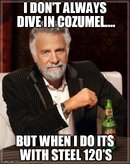Sue Sue
Contributor
- Messages
- 1,748
- Reaction score
- 511
- # of dives
- 500 - 999
Skittl..in time I would put bets that you will see your bottom time exceed your 51 min average. Once you conquer your "Freak out" , get more experience with buoyancy, and become more comfortable with the general routine you could very well see those 70 min. dives. Most importantly, Do Not take to heart what others are doing. Take your time, relax your breathing and get your weights right. Overall, experience is the best way to improve your bottom time.




